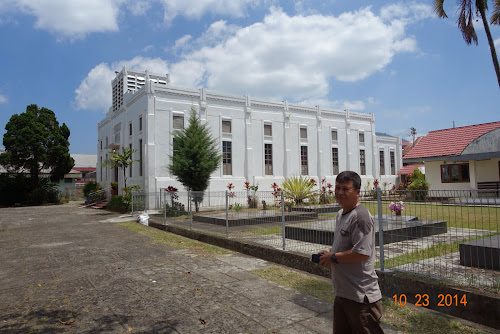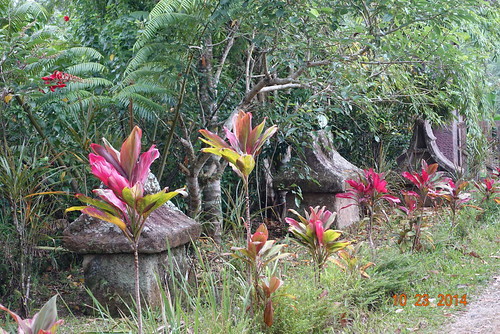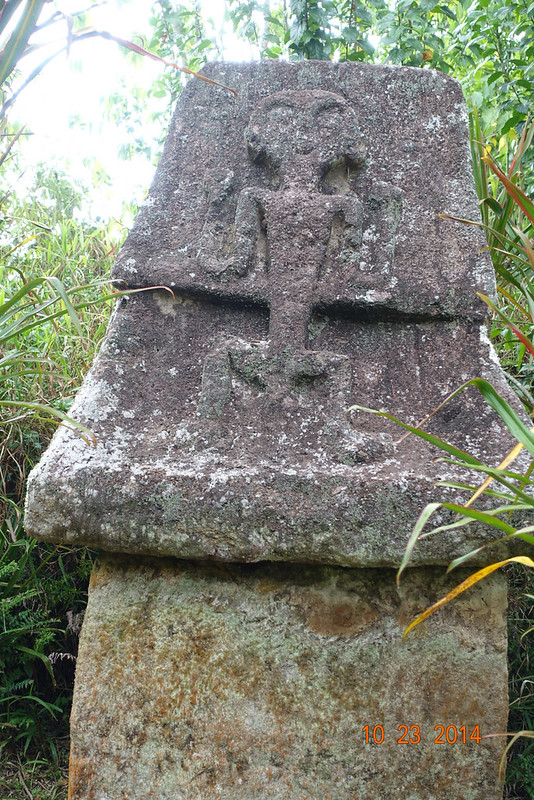Tomohon Indonesia
I am writing this during a 4 day reprieve from traveling at a dive center where we snorkel and laze around, sitting on our balcony overlooking the Manado sea. As we stupidly burnt our skins to almost unbearable tenderness on the very first snorkeling trip, we are really just reading, writing and sleeping. So the below was concocted in 3 or 4 "stop start" attempts. And in the end I consider it mediocre in content. As always the pictures will have to save the show.
Well, here I am at long last, in the city my parents, brother and I left in 1950, as the transition to the new Indonesian government was complete. The country side of this 27,000 plus people town is lush, abound in flowers, because we are at 800 meter or 2500 ft plus elevation above sea level. We are almost on the equator and between rainy seasons, but at this height temperatures are cool.
We flew in late afternoon in Manado about an hour away from Tomohon on the island of formerly Celebes now renamed as Sulawesi. However the tribal lands here are still called the Minahasi.
This a very Christian world. Tomohon is 70% Protestant in all possible denominations and 25% Roman Catholic. The final 5% is Muslim, Buddhist or Hindu. Old writings about this area of former head hunters, states often, that one finds a church on every street or about every 100 meters. Slightly exaggerated but in essence true. Dutch missionaries during the 300 years of colonizing in Indonesia and especially in spice rich Minahasa did such a good job, that during the time of transition from dutch colony to independent nation, the Minahasa requested to become the 12th province of the Netherlands.
R
We stay at Gardenia, aptly called so, as the creation of Mrs Ratulangi's gardens makes it a little Eden. Although, we only witnessed little land frogs hopping around, thus we never saw Eden's resident snake to seduce us into eating the apple (maybe since we don't qualify as Adam and Eve in so many ways)
Dokter Ratulangi, a relative of the well known Minahasan, Dr Sam Ratulangi, who was the first post colonial Indonesian governor of Sulawesi (my father must have had multiple dealings with the new governor), the island that we are visiting here, welcomes us and lays out a program of things we need to see in my rediscovery of the town of my childhood. He has studied the pictures sent and warns me not much remains anymore of what he saw in the photos he received.
We travel the next three days with Henry our driver guide who learned English in school and improved on that by singing English songs. He was one of the best guides we have had so far on our trip and he always managed to explain things to us in such a way that we grasped the meaning of what he wanted to convey. And in those instances that he did not find the words, he would never give up trying to get his story across.
What we learned from him:
Indonesia has 250 million people, Minahasa has 1 and 1/4 million people on the island of Sulawesi where 15 million people live. So this is an outpost of the country, where by the way the central government is not much liked.
There was even an uprising in the 1950's that lasted several years, demanding more autonomy, as Minahasans felt they were taxed poor and paid bottom prices for their crops by the national government who controlled the local spice industry for years.
About 90% of all children here complete a 12 year education.
Another Henry statement: "Bali is western,not indonesian"
Because of its temperate climate many rich Indonesians (Henry says Chinese people too) buy land here to build vacation homes on land outside the city that they buy at $0.80 a sq ft. Downtown land prices are 10 fold.
Henry and his forefathers believe that for home construction one should cut the wood during a specific phase of the moon cycle for the wood to last and be insulated against termites.
Mt Lokon the mountain that defines Tomohon's skyline has erupted tens of times since July 2011 and just last month showered volcanic ash all over town. The benefit of all of this is very fertile soil for the flower industry (we see nurseries everywhere) and for general farming here (A lot of spice farming, like cloves, cinnamon and nutmeg). The other slightly lower mountain Mahawu is more docile in its behavior.
Gas is rationed here (we see lines and lines of cars at the gas stations everyday). All along the roads you will see coca cola liter bottles filled with gasoline at a price about 25% higher than the gas station prices.
Global warming has changed weather patterns here and this last January heavy rains swallowed several sections and a bridge of the highway between Tomohon and the larger coastal city of Manado with a death toll of 31 people, several swept away in their cars on their way to work on an early Monday morning.
The next day we visited the Tangkoko rainforest, where we saw macaque apes and the rare tarsier, a 31/2 oz, 3 1/2 inch monkey that lives during the day in holes in trees awaiting dusk, when the cicadas, their food source come out. Our guide led us to such a tree, where we saw the monkey in its protective place, shielding him from big birds and pythons. (I had not told Sandee about the abundance of snakes in this forest ahead of time) We waited an hour for him to come out at the time the cicada started serenading the forest.
The one amazing other experience was Tomohon's "export" product: beautifully carved wooden houses, erected on the spot with nails driven in halfway for easy dismantling and shipment to locations as far as Bali, at the cost of 17 dollar per sq ft.
Another interesting factoid was that dokter Ratulangi, who was the director of the local catholic hospital we visited, qualified the hospital first and foremost as "clean". If that is the outstanding feature, what then to think of all other hospitals in the region?
And yes staff was everywhere disinfecting walls and ceilings, so it was definitely clean.
We never found wine in the Indonesia we visited so far, which for us is a reason to look for more civilization.
We visited the large and very famous market in Tomohon, where we found beyond spices, all kind of unusual proteins consumed here. Sandee has requested to post pictures of them at the end of this blog, so that the more sensitive among you can skip looking at them. To paraphrase, you will find pets among them.










































































Comments
Post a Comment